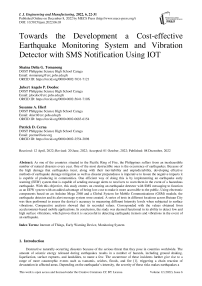Towards the Development a Cost-effective Earthquake Monitoring System and Vibration Detector with SMS Notification Using IOT
Автор: Shaina Delia G. Tomaneng, Jubert Angelo P. Docdoc, Susanne A. Hierl, Patrick D. Cerna
Журнал: International Journal of Engineering and Manufacturing @ijem
Статья в выпуске: 6 vol.12, 2022 года.
Бесплатный доступ
As one of the countries situated in the Pacific Ring of Fire, the Philippines suffers from an inexhaustible number of natural disasters every year. One of the most destructible ones is the occurrence of earthquakes. Because of the high damage that earthquakes incur, along with their inevitability and unpredictability, developing effective methods of earthquake damage mitigation as well as disaster preparedness is imperative to lessen the negative impacts it is capable of producing in communities. One efficient way of doing this is by implementing an earthquake early warning (EEW) system that is capable of sending message alerts to receivers to warn them in the event of a hazardous earthquake. With this objective, this study centers on creating an earthquake detector with SMS messaging to function as an EEW system with an added advantage of being low-cost to make it more accessible to the public. Using electronic components based on an Arduino Mega 2560 and a Global System for Mobile Communications (GSM) module, the earthquake detector and its alert message system were created. A series of tests in different locations across Butuan City was then performed to assess the device’s accuracy in measuring different Intensity levels when subjected to surface vibrations. Comparative analysis showed that its recorded values. Corresponded with the values obtained from accelerometer-based mobile applications. In conclusion, the study was deemed functional in its ability to detect low and high surface vibrations, which proves that it is successful in detecting earthquake tremors and vibrations in the event of an earthquake.
Internet of Things, Early Warning Device, Monitoring System
Короткий адрес: https://sciup.org/15018599
IDR: 15018599 | DOI: 10.5815/ijem.2022.06.03
Текст научной статьи Towards the Development a Cost-effective Earthquake Monitoring System and Vibration Detector with SMS Notification Using IOT
Destructive naturally-occurring disasters because of the serious threat that they pose in countries worldwide. The amount of seismic energy released during earthquakes results in a number of hazards, including ground shaking, liquefaction, surface ruptures, and landslides, to name a few. The occurrence of these incidents further give rise to a range of more catastrophic events such as tsunamis, seiches, floods, and fire [1], triggering a chain reaction of devastation in affected areas. Depending on the earthquake’s intensity, the severity of these risks makes earthquakes a threat to both human lives and infrastructure as the widespread damage that occurs cannot be controlled.
In the Philippines, a number of seismological events have been recorded that caused massive destruction to both rural and urban communities. In the past 25 years, the Bohol earthquake of October 2013 has been considered the strongest and most destructive natural disaster to affect the country with the cost of damages amounting to more than Php2 billion in terms of infrastructure, while the number of casualties was reported to be 227 in total from the affected provinces in Visayas [2]. In April 2019, an earthquake of magnitude 6.1 also struck Central Luzon and caused a loss of revenue amounting to an estimated worth of Php539 million, with 18 fatalities and more than 18,000 affected persons
[3] . These demonstrate the range of devastating impacts that may arise in the event of this natural disaster, which call for an effective plan of action to mitigate the effects of earthquakes.
2. Related Works
2.1 Earthquake Early Warning Systems2.2 Developments Utilizing Arduino to Detect Shaking
A low-cost, Arduino-based single-axis shake table called SARSAR was created to test the dynamic behavior of scaled structure models, according to a study by Sekerci (2018) [9]. By creating software programs utilizing an Arduino DUE board, the horizontal components of the acceleration records from previous earthquakes are scaled and sent to the shake table. With Arduino compatible sensor modules, the shake table's displacement and acceleration reactions to the intended motion are also captured. A data gathering device based on an Arduino MEGA board measures the table's response to provide proof. A stepper motor, ball screw assembly, and linear bearings-based linear actuator system transmits the seismic ground motion along the horizontal axis to the shake table.
2.3 The Use of Accelerometers in Other Studies
Responses to this phenomenon were in the thought of many researchers who came up with different strategies for early earthquake detection through a range of technology-based studies. In the study of Burkett et al. [4], 400 ground motion sensors were used to constitute a large-scale earthquake early warning (EEW) system along with a network of data sources and computer algorithms to detect earthquakes within the first few seconds of shaking and immediately transmit region-wide alerts to individuals in the West Coast area, accomplished via microwave or telemetry systems. Similarly, Hsiao et al. [5] also formulated an EEW system in Taiwan composed of a real-time strong-motion network based on P-wave detection; however, this design lacks a wide coverage area. Although these studies enable rapid detection of tremors and dissemination of information, the high inaccessibility and high financial cost of the materials used for production limit their ability to be adopted by developing nations. A number of studies aimed to address this problem, such as the creation of an EEW system by Bajgain et al.[6] using Arduino software and the Global System for Mobile Communications (GSM) module. However, the lack of sensors and an alarm system hinder this device from providing an accurate reading of the range of detection. The objective of the study is to serve a warning system by sending out an automated message and an alert when an earthquake occurs where the financial cost of production will be substantially lower than the expansive early seismic warning systems now being developed since it uses costeffective components.
Hence, from these limitations, the researchers recognized the need to create an earthquake-detecting device based on the concept of developed EEW systems using relatively inexpensive materials.
Earthquakes pose a considerable hazard to life and property in metropolitan areas close to significant active faults on land or offshore subduction zones as urbanization spreads across the globe. According to Wu and Kanamori's findings [7], Earthquake Early Warnings (EEWs) can be effective tools for lowering the risk of earthquakes if the location of cities in relation to earthquake sources is favorable for such warnings and the local populace is properly trained to react to the warning signals. Wen et al. [5] developed their own EEW systems with a network structure in Taiwan. An earthquake early warning (EEW) system has been built in Taiwan thanks to the Central Weather Bureau's (CWB) establishment of a real-time strong motion network. A virtual sub-network strategy based on the regional early warning approach was used in the initial stage to reduce the earthquake response time. This EEW system has responded to 225 occurrences with a magnitude greater than 4.5 that have occurred in Taiwan's interior or offshore since 2001. Within 20 seconds of an earthquake's occurrence, the system can report it and provide accurate magnitude estimates for earthquakes up to magnitude 6.5. Currently, the CWB system uses a P-wave approach. Peak displacement amplitudes from initial P waves (Pd) can be utilized to identify M 6.0 events, according to research based on data from 596 M 4.0 earthquakes captured by the real-time strong motion network. The initial P waves' characteristic periods, c and pmax, can be utilized to determine magnitude with an uncertainty lower than 0.4. The experts anticipate that the EEW system in Taiwan will soon reach a 10 second reaction time.
More than 143 million Americans reside in places with high seismic risk on the West Coast of the country, which presents a national challenge due to earthquakes. This population is spread throughout 39 states. The United States' West Coast is where the majority of the nation's earthquake risk is concentrated. The average annualized loss from earthquakes is estimated by the Federal Emergency Management Agency (FEMA) to be $6.1 billion nationwide, with Washington, Oregon, and California accounting for 45% of that total ($4.5 billion) and California alone accounting for 61% ($3.7 billion). On the Cascadia subduction zone, California has a 99.7% chance of experiencing an earthquake with a magnitude of 6.7 or higher in the next 30 years, and the Pacific Northwest has a 10% chance[4]. Kong et al. MyShake's seismic network app for smartphones was developed to gather information and analyze earthquakes in order to alert users. Smartphone accelerometers can also be used to detect earthquakes, and smartphones are considerably more common than old networks, therefore they can be utilized as seismic systems. The findings demonstrate that smartphones can capture magnitude 5 earthquakes at a distance of little more than 10 km and can also build an earthquake detection capability to distinguish earthquakes from common tremors. Their proof-of-concept system then gathers seismic data at a central point where a network detection algorithm verifies the existence of an earthquake and instantaneously determines its location and magnitude. Then, a warning of impending earth shaking can be sent out using this information.
The accelerometer was utilized by Hina et al. [10] to detect pre-earthquake vibrations along any of the three axes. As vibrations take place, the accelerometer detects them and converts them into equal ADC values. Additionally, Arduino controls the 16x2 LCD, LED, and buzzer. It also computes and compares values to determine the best course of action. The accelerometer produces analog voltages in three axes after detecting earth vibration (X, Y, and Z). The LCD is used to display alarm messages in addition to the values changing on the X, Y, and Z axes. Arduino is connected to this LCD in 4-bit mode.
An earthquake monitoring and warning system that can both identify earthquakes and alert people to take essential actions is the goal of a project by Bera et al. Therefore, a low-cost automatic microcontroller-based system that senses earthquakes and gas leaks through an accelerometer and a gas sensor, respectively, has been conceived and constructed utilizing low-cost electronic components acquired locally. In the event of an earthquake, the microprocessor controls a relay and a motor that shut off gas and electrical supply, respectively, helping to avert potential calamities. An accelerometer is a tool that monitors the acceleration that an item experiences and produces an equivalent electrical output, according to Bera et al. Both static and dynamic forces can be measured by the apparatus.
Strong-motion accelerographs are situated at crucial INEEL site facilities, and 26 seismic stations are operated remotely from southeastern Idaho by the Idaho National Engineering and Environmental Laboratory (INEEL). The typical analog instrumentation at each seismic station in the INEEL seismic network has recently been replaced with digital recording devices. 900 MHz wireless modems are used to send seismic data to a central recording facility in Idaho Falls, Idaho. The 25 analog film-recording strong-motion accelerographs have been replaced by digital recording systems, according to INEEL[12].
2.4 Using GSM (Global System for Mobile Communications) Modules with Arduino for Early Warning Systems
2.5 Conclusion of Related Studies
3. Materials and Methods
3.1 Preparation of Experimental Units
By combining an Arduino microcontroller with an accelerometer sensor in a wireless network that connects an external device, such as a mobile phone, to the microcontroller, Bajgain et alstudy .'s [6] established an Automated Safety System. The consumer is immediately informed by SMS and receives a message on their phone (Short Message Service). GSM shield is used to link the microcontroller to the smartphone. By altering the specified parameters in the Arduino code, the sensitivity of the earthquake detector can be changed. When an earthquake occurs, the message sends a warning message by SMS and sounds an alarm to alert residents of the community where the device has been installed.
Gnotthivongsa et al. [12] conducted a study on Real-time Corresponding and Safety System to Monitor Home Appliances based on the Internet of Things Technology, a smart home application to support real-time correspondence to reduce the cost of implementation, to pursue life intelligence and comfort, with the hope that the system is able to provide a significantly more convenient and efficient energy consumption for the daily activities of the family. The advanced features of this application—which include monitoring, control, and information support systems as a one-stop-service application to help users learn more about their environment and serve as a bridge between users and home appliances—include real-time notification in the event that an emergency occurs inside the home. On the other side, a study by Faryad et al. [13] that examines the effects of Internet of Things technology intends to examine how IoT, as a persuasive technology, might influence human behavior and raise consumer awareness of and satisfaction with IoT goods. How will the infrastructure of the Internet of Things help people alter their attitudes and actions toward certain ordinary work? This study found that the suggested convincing (IoT) Infrastructure, which is made up of four scenarios, has a somewhat positive acceptability rating. Performance, ease of use, and support had the biggest effects on peoples' intentions to use the suggested infrastructure. Gender moderates the impact of social influence, according to social persuasion, so that men are more influenced by their social surroundings than women are. Assistance matters, though, as (IoT) infrastructure can be utilized to help people live healthier lives.
Existing research demonstrates that the majority of early earthquake warning system development in many nations and regions involves large-scale applications. Since they aim to transmit an alarm to a large number of people in a certain nation or region, these propose a high cost of planning, building, and implementation. Despite the fact that the other studies cited achieved the present study's objective of using the Arduino platform as a reasonably priced alternative for earthquake detection, the lack of output and storage systems and a method of data transmission prevented the aforementioned devices from potentially becoming the ideal prototype for an alarm system that the general public could use during and after earthquakes. The accuracy of the devices in other research likewise demonstrated that the system's accuracy was impaired when the speedy reaction was given priority.
Thus, the researchers' suggested device attempts to serve as an earthquake warning system by sending out both an alarm and an automated message. The financial cost of production will be substantially lower than the large-scale early earthquake warning systems now being developed since it uses materials that are cost-effective. Additionally, it incorporates components from the Global System for Mobile Communications (GSM) and Arduino platforms, both of which have been shown in the reviewed literature to be efficient in detecting earthquakes and sending out alert messages. Additionally, it seeks to overcome the shortcomings of the cited studies' features by ensuring that efficient tools are utilized for data storage, output, and transmission.
The main program for building a device capable of acting as a prototype of an earthquake detector with a built-in alarm system was an open-source embedded prototyping system called Arduino that allows users to make interactive electrical items. An Arduino Mega 2560 was utilized as the project's microcontroller. This microprocessor regulates the device's ability to detect acceleration values in order to identify earthquakes and gauge their strength. It requires a USB connection to a computer, an AC-to-DC adapter, or a battery to turn on. The movement or vibration of the Earthquake Warning and Detector is measured using the accelerometer, an electromechanical device used to measure acceleration forces. Real-time access to the recorded data is made possible by the real-time clock (RTC), which keeps tabs on the current time of each earthquake that is detected. Data can be moved to and from the device via the SD card module. The recorded intensity level is shown on the 2x16 LCD along with the device's measured data. In order to instantly inform consumers during an earthquake, the LEDs light up in accordance with the level when intensity levels are detected at five or higher.
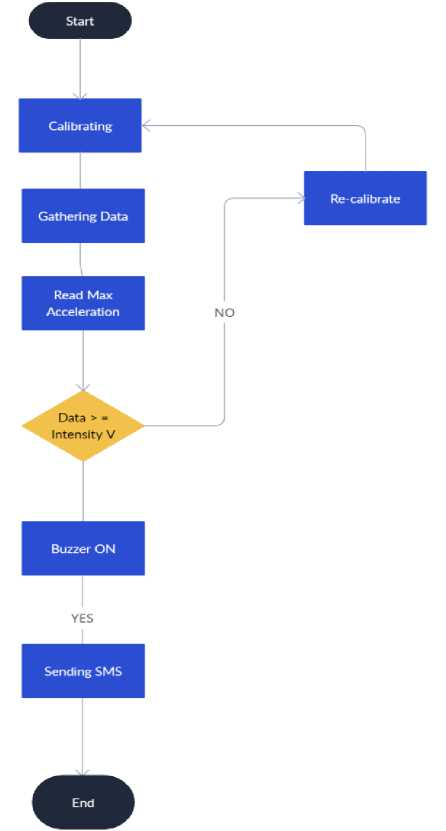
Fig. 1. Flowchart of the Earthquake Detection
Using the NEO-6m GPS Module, the Earthquake Warning and detector was successfully linked to a preprogrammed GPS receiver in order to transmit the location of an earthquake wave detected by a monitoring system that is situated in a particular area. This allowed the Arduino microcontroller to deliver information about the detected earthquake with respect to the location tracked by the satellites and pinpointed by the Neo-6M GPS chip on the GPS Module. As a low-power component, the GPS Tracking worked effectively with the Arduino-based Earthquake Warning and interface and the Arduino IDE. Adding the solar panel, the device powerbank can now charge independently without using electricity. This feature allowed Earthquake Warning and to work 24/7, which is vital in detecting ground vibrations since the occurrence of earthquakes are unpredictable. In addition, incorporating the use of renewable energy makes the Earthquake Warning and earthquake detector an eco-friendly device.
3.2 System Flow and Operation
3.3 Earthquake Warning Conceptual Design
4. Experimental Setup
4.1 Assembly of The Earthquake Detector
The device will be turned ON when a USB cord will be connected to a power source such as a power bank. It will then begin to initialize by calibrating. After the initialization, the program flow begins as the device continues reading the maximum acceleration detected on the area it is placed. All intensity levels detected are shown through the Liquid Crystal Display (LED) of the device. If its acceleration values correspond to an intensity level of five or higher, it proceeds to powering on the buzzer system and sending the SMS alert message through the Global System for Communications Module (GSM). The measured value of the intensity as well as the time detected will then be saved in a Secured Digital card module (SD card) to allow users to access and view recorded data in real-time.
The assembly of the project involved the integration of all the electronic components with the device’s structural frame. The electronic components were all supplied from a 5-volt power bank. The construction of the output was aided by the Computer Aided Design (CAD) shown in Figure 2.
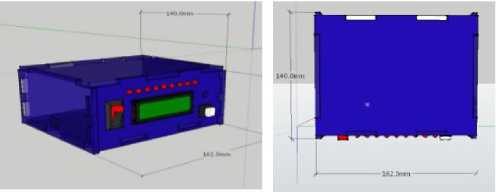
Fig. 2. Isometric and Top View

Fig. 3. Front and Back View
The figure below is an earthquake detector that utilizes Accelerometer Sensor which detects surface vibrations through acceleration in meter per second squared (m/s²). The device can read motions from the x, y, z axes. Additionally, the number of LED lights in the device corresponds to the Intensity Level in the intensity scale.
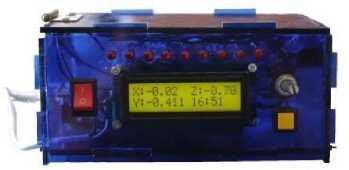
Fig. 4. The Earthquake Warning and Earthquake Detector
-
4.2 Preparation of Treatments
-
4.3 Testing and Evaluation
At the Philippine Institute of Volcanology and Seismology, test values were compared in order to calibrate the device and gauge its accuracy and precision (PHIVOLCS). These findings were compared with the earthquake simulator developed by the PHIVOLCS, and they were further assessed using a smartphone application called MyShake after a testing exercise was conducted on the Macapagal Bridge in Butuan City. To assess and visualize the relevance of the trials, the data gathered from the studies was transformed into graphs. The Computer Numerical Control (CNC) equipment determined the outputs and recorded the information in the device's database to graph the vibrations.
During the testing, the experimentation options were the following: the Butuan City Macapagal Bridge, the PHIVOLCS earthquake simulator (comparison), and the MyShake application. The device was aligned with the road such that the X-axis and Y-axis are in the lateral and longitudinal direction of the road, respectively, while the Z-axis is the vertical direction. By this, a triaxial component of the vibration wave was registered simultaneously.
A total of 4-minute data was obtained per test location consisting of a 2-minute measurement session with a 2-minute interval. Data collection from the accelerometers was performed during two 2-minute sessions. Sample plots of the raw signals from the test location were compared through graphs.
Fig. 6. On the road city
On the table:
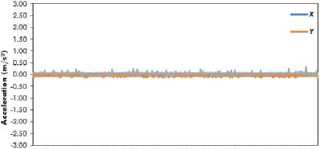
Time (s)

Thwto
Fig. 5. Graphs of the Surface Vibration during testing
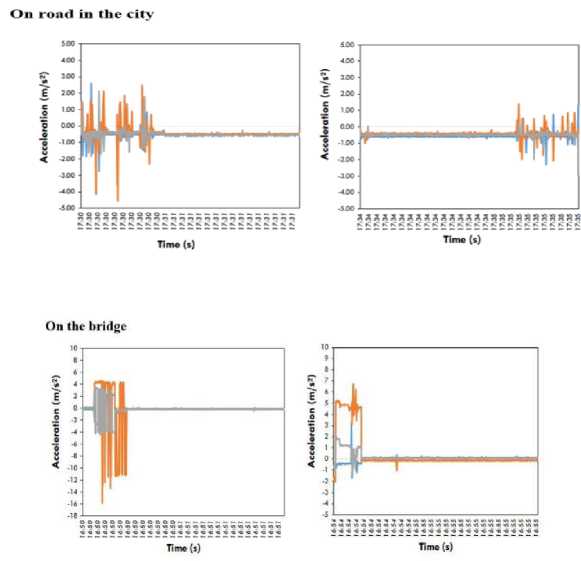
Fig. 7. On the Bridge
On Bumpy road
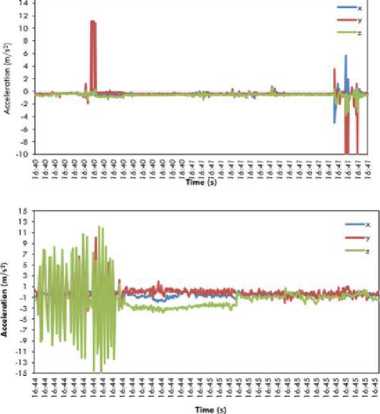
Fig. 8. On the bumpy Road
Table 1. Result of Movement Testing of Different Areas (Device)
|
MyShake Application |
||
|
Location |
Intensity Scale |
Description |
|
1. on the table |
No Earthquake |
Not Felt |
|
2. on road near the bridge |
I-II |
Slightly felt |
|
3. On the bridge |
II- III |
Weak |
|
4. Bumpy Road |
VI |
Strong-Very Strong |
Table 2. Result of Movement Testing of Different Areas (MyShake Application)
|
Device: |
||
|
Location |
Intensity Scale |
Description |
|
1. on the table |
No Earthquake |
Not Felt |
|
2. on road near the bridge |
II |
Slightly felt |
|
3. On the bridge |
III |
Weak |
|
4. Bumpy Road |
VI- VII |
Strong-Very Strong |
-
4.4 Data Transmission from Device to Mobile Phone
At the end of each recording, the Intensity Level data transmitted as a GSM text message, using the Arduino SIM808 module, towards a GSM modem of the computer used a server. The GSM text messaged will be processed using an SMS Gateway in order to store the recorded data to a database. In sending alert messages, the device took a maximum of 10 seconds to disseminate information about vibrations that reach intensity levels equal to or higher than 5.
Power Source * Arduino device ---► SIM 608 Module
GSM Modem of
SMS Gateway <--- Computer
Fig. 9. SMS Notification
The effectiveness and accuracy of the earthquake early warning system were evaluated by setting it up in four different test environments: on a table, on a rough road, in the city, and on a bridge, where its intensity scale and outcomes were compared with those obtained using the MyShake application. Two-wheeled motorcycles, four-wheeled cars, and ten-wheeled trucks could all be seen passing at the test sites. The surface vibration detector recorded changes in intensity levels for each location as a result of these passing cars, which also affected the detector's findings.
Through the Arduino code, which was stored on the SD card, the accelerometer values in the x, y, and z directions as displayed in the plotted graphs of data were transformed to intensity levels. To keep and examine the entire set of data, this SD card can be taken out of the device and put into a different one, like a laptop computer. As soon as the device detects vibrations, LED lights will flash, with the amount of lights flashing fluctuating depending on the earthquake's severity level. A built-in buzzer system is also placed in addition to the LED lights, and it will activate when the detected intensity level reaches a value of 5 or higher. The GSM module relays the processed information to the registered cellphone in 10 seconds for SMS transmission.

TeehTonlc
Earthquake Intensity VII
Earthquake Intensity VIII
Earthquake Intensity VI
Earthquake Intensity VI
Earthquake Intensity VII
Earthquake Intensity VII
Earthquake Intensity VI
Earthquake Intensity VI
Earthquake Intensity VII
Earthquake Intensity VII
Earthquake Intensity VI
О @6 ТевМе^е О
•о а о о°e
Fig. 10. Results of Earthquake Alert Message Sent by GSM and IoT system
The earthquake early warning system was assessed for its accuracy and functionality by placing it on four different test locations: on a table, on a bumpy road, in the city, and on the bridge where its intensity scale and results were compared with those using the MyShake application. The test locations used had the presence of passing vehicles such as 2-wheeled motorcycles, four-wheeled vehicles, and 10-wheeled trucks. These passing vehicles contributed to the results of the surface vibration detector, causing changes for each location in its recorded intensity levels.
Accelerometer values in x, y, and z directions as shown in the plotted graphs of data were converted to intensity levels through the Arduino code, which was stored in the SD card. This SD card is removable from the device and can be inserted into a device such as laptop computer in order to store and view the full set of data. Once the device detects the vibrations, the LED lights will flash, with the number of lights varying according to the detected intensity level of the earthquake. In addition to the LED lights, a built-in buzzer system is also installed to produce a buzzing sound when the detected intensity level reaches values of 5 or higher. For the SMS messaging, it takes 10 seconds for the GSM module to relay the processed information towards the registered mobile phone numbers of receivers. Along with the earthquake’s intensity levels, the automated alert message will also include precautionary warning as well as the location of the device.
5. Conclusion and Recommendation
In conclusion, this device successfully addresses the limitations of existing earthquake early warning detectors while being more cost-effective. Unlike the large-scale monitoring systems mentioned in the Review of Related Literature Section, this device is comprised of a portable earthquake detecting device that can quickly achieve information dissemination to registered mobile phone users within a specific area. It is not reliant on the speed of the warning system and its distance from the epicenter as the SMS Messaging of this device takes approximately 10 seconds regardless of other factors, while other studies may take around 20 seconds or more.
Additionally, the device’s portability makes it more adaptable for public use. The use of accessible hardware and software components makes it generally cheaper than the abovementioned existing devices. As seen in the cost analysis, the device only costs $40.58 in comparison to the rest. While there is the JDS c-88quake Earthquake Alarm with nearly the same amount, it does not have certain features such as SMS Messaging and information dissemination which sets it apart from our device. This research, the development of an Arduino-based surface vibration detector with SMS messaging as a potential cost-effective earthquake early warning system, is successful in its objectives that it was able to develop a portable and low-cost earthquake early warning system affordable by the general public as existing safety systems are costly and limited to the privileged, integrate Arduino with a motion-sensor accelerometer that connects the external device (a cell phone) to the microcontroller, and incorporate the modern way of information dissemination (i.e.
SMS messaging) and the concept of alarm systems to create a convenient and effective warning system – all of which are functional and serve their purpose.
Additionally, the device was able to include features such as how the accelerometer can detect ground vibrations in three axes, and the attachment of the alarm system that will buzz and create a noise if the device detects shaking from Intensity V and higher, features that all fall under the primary objective of being a device that aids safety during natural disasters, specifically an earthquake. To truly justify its precision and accuracy in results, the device was tested and placed in select locations such as on the table, on a busy road, on the roof of a bridge and near a constantly moving machine where its intensity scale and results were compared with that of PHIVOLCS and MyShake application. The outcome of the comparison shows that the device is indeed functional and accurate in its ability to detect low to high vibrations, which shows its potential in detecting tectonic-related vibrations. In conclusion, this is a useful device and can be a cheap handy earthquake detector, which can be mounted in different institutions, especially schools, offices and other local government units and Disaster and Risk Reduction Units. The researchers strongly recommend the following: 1) further calibration and sensitivity testing; and 2) to perform different tests to determine the time delay between sampling data and the application software processing of information.
Список литературы Towards the Development a Cost-effective Earthquake Monitoring System and Vibration Detector with SMS Notification Using IOT
- Endsley, K. (2007). What are Earthquake Hazards? Retrieved January 08, 2021, from http://www.geo.mtu.edu/UPSeis/hazards.html.
- National Disaster Risk Reduction and Management Council. (2013, November 4). FINAL REPORT re Effects of Magnitude 7.2 Sagbayan Bohol Earthquake. http://ndrrmc.gov.ph/attachments/article/1330/FINAL_RE PORT_re_Effects_of_Magnitude_7_2_Sagbayan_Bohol_ Earthquake_15OCT-04NOV2013.pdf
- National Disaster Risk Reduction and Management Council. (2019, May 3). Sitrep No. 15 re Magnitude 6.1 Earthquake in Castillejos, Zambales. https://ndrrmc.gov.ph/attachments/article/3754/SitRep_N o_15_re_Magnitude_6_1_Earthquake_in_Castillejos_Za mbales_as_of_05APR2019_0600H.pdf.
- Burkett, E., Given, D., & Jones, L. (2017). ShakeAlert—An Earthquake Early Warning System for the United States West Coast. (ver. 1.2, February 2017): U.S. Geological Survey Fact Sheet 2014–3083, 4. doi: 10.3133/fs20143083.
- Wen, K.-L., Shin, T.-C., Wu, Y.-M., Hsiao, N.-C., & Wu, B.-R. (2009). Earthquake Early Warning Technology Progress in Taiwan. Journal of Disaster Research, 4(4), 530–538. https://doi.org/10.20965/jdr.2009.p0202
- Bajgain, S., Nayak, P., Subedi, A., Pandey, D. & Chethana, C. (n.d.) Earthquake early warning system with real time messaging. Department of CSE. Retrieved from https://www.researchgate.net/profile/Prakash_Nayak15/p ublication/325780057_EARTHQUAKE_EARLY_WAR NING_SYSTEM_WITH_REAL_TIME_MESSAGING/li nks/5b2359f60f7e9b0e37488599/EARTHQUAKE-EARL Y-WARNING-SYSTEM-WITH-REAL-TIME-MESSAG ING
- Wu, Y.-M., & Kanamori, H. (2008). Development of an Earthquake Early Warning System Using Real-Time Strong Motion Signals. www.mdpi.org/sensors
- Kong, Q., Allen, R. M., Schreier, L., & Kwon, Y. W. (2016). Earth Sciences: MyShake: A smartphone seismic network for earthquake early warning and beyond. Science Advances, 2(2), 1–9. https://doi.org/10.1126/sciadv.1501055
- Damcı, E., & Şekerci, Ç. (2018). Development of a Low-Cost Single-Axis Shake Table Based on Arduino. Experimental Techniques, 43(2), 179–198. https://doi.org/10.1007/s40799-018-0287-5
- Hina, K. & Kumari, S. (2018, April). Earthquake detector. International Journal of Advance Research in Science and Engineering. Retrieved from http://www.ijarse.com/images/fullpdf/1523964674_IIMT 31.pdf
- Bera, P., Sahoo, R. & Nanda, C. (2020, January). Earthquake Detection and Warning System for Automatic Cut-Off of Electricity and Gas Supply Lines for Safety Measures. (vol. 9, January 2020): International Journal ofInnovative Technology and Exploring Engineering, 2278-3075p., Retrieved from http://www.ijitee.org/wp-content/uploads/papers/v9i3/C8144019320.pdf
- Nalinsak Gnotthivongsa, Huangdongjun, Khamla Non Alinsavath, "Real-time Corresponding and Safety System to Monitor Home Appliances based on the Internet of Things Technology", International Journal of Modern Education and Computer Science(IJMECS), Vol.12, No.2, pp. 1-9, 2020.DOI: 10.5815/ijmecs.2020.02.01
- Shagufta Faryad, Hira Batool, Muhammad Asif, Affan Yasin, "Impact of Internet of Things (IoT) as Persuasive Technology", International Journal of Information Technology and Computer Science(IJITCS), Vol.13, No.6, pp.16-28, 2021. DOI: 10.5815/ijitcs.2021.06.02
- Holland, A. (2003, January 1). Earthquake Data Recorded by the MEMS Accelerometer: Field Testing in Idaho. Seismological Research Letters; 74 (1): 20–26. https://doi.org/10.1785/gssrl.74.1.20

